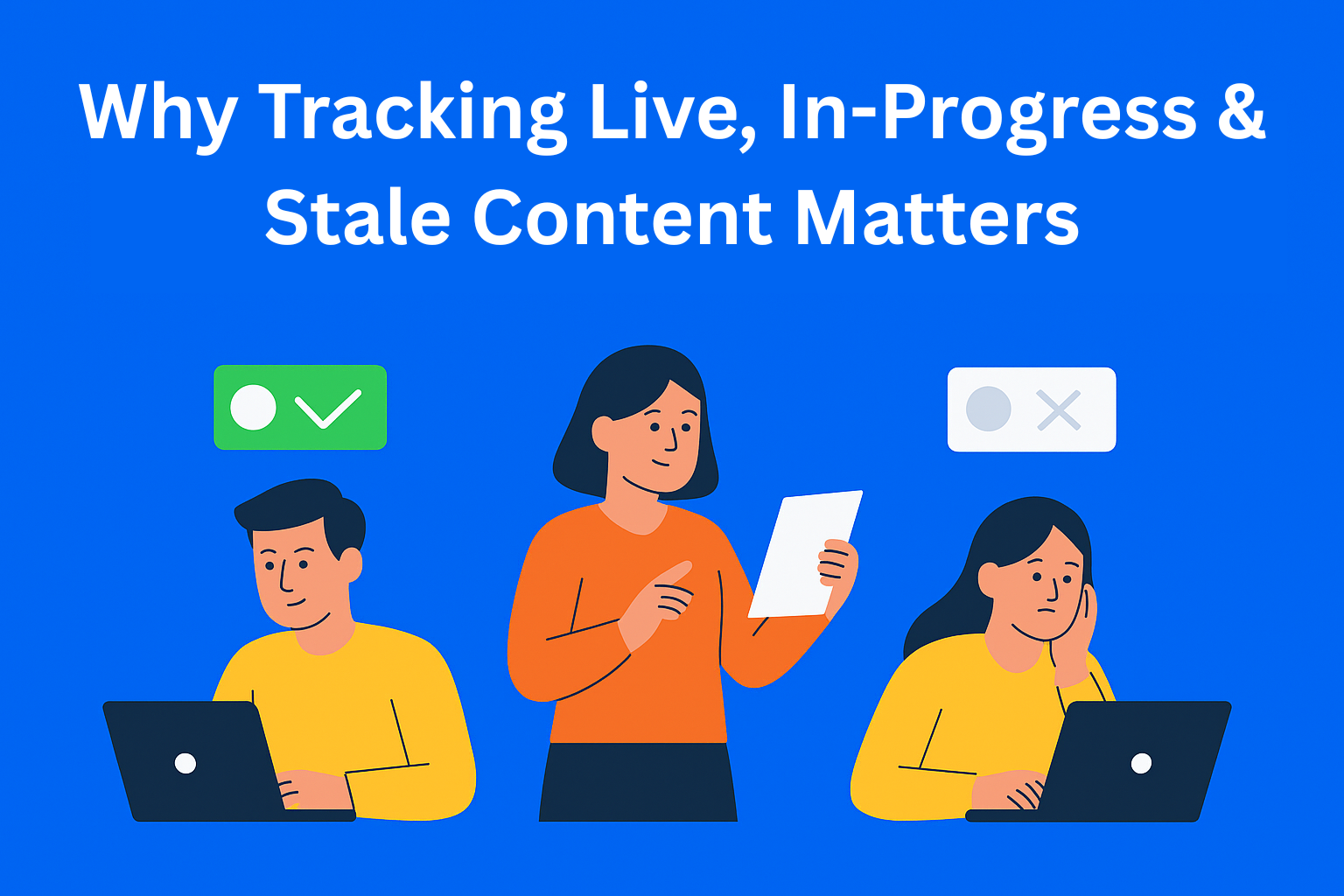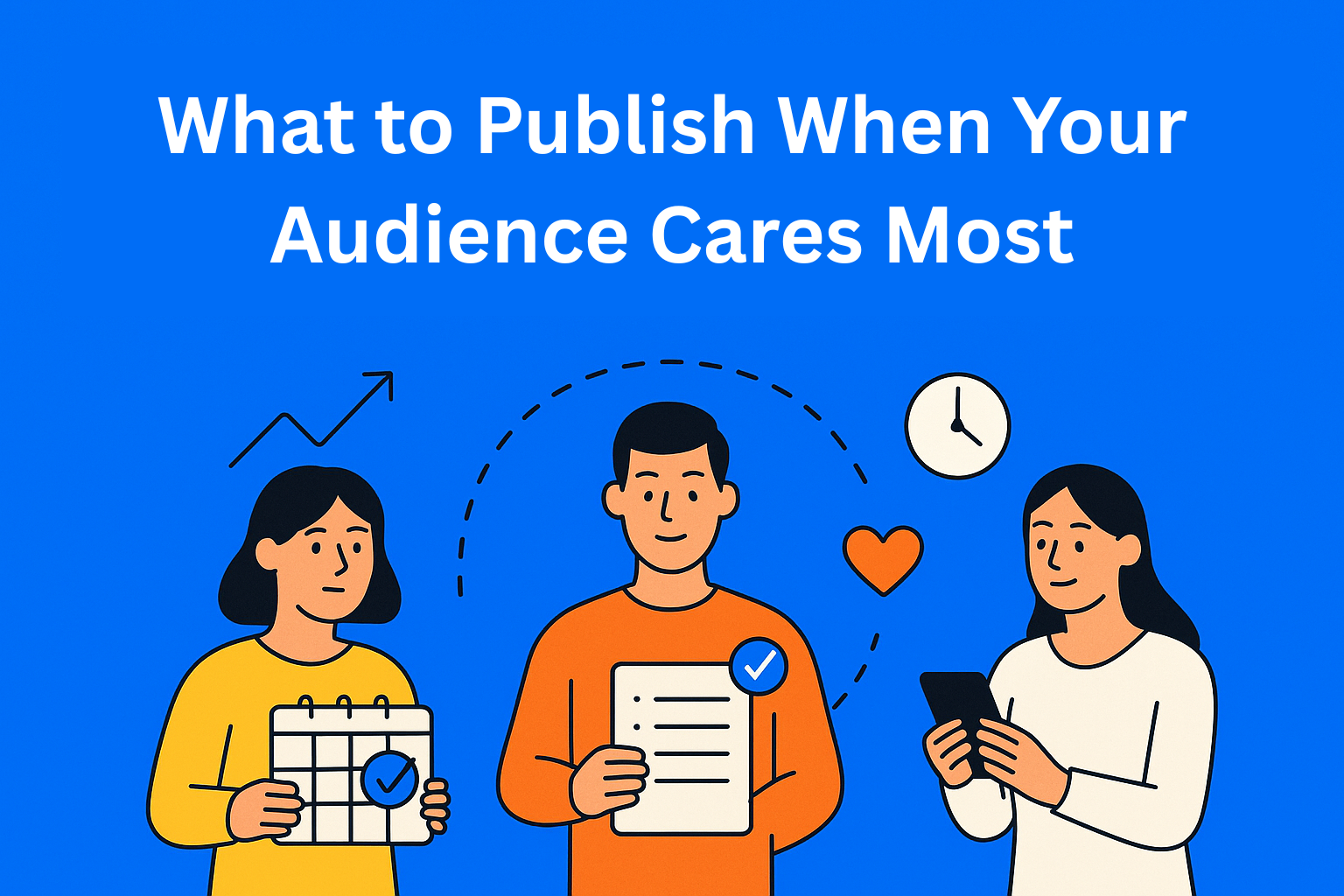Common Content Planning Mistakes That Hinder Growth and How to Fix Them
Discover the biggest content planning mistakes holding your brand back and how to fix them. From missed SEO to scattered collaboration, this guide shows how tools like EasyContent help teams stay on track and grow through smarter content strategy.
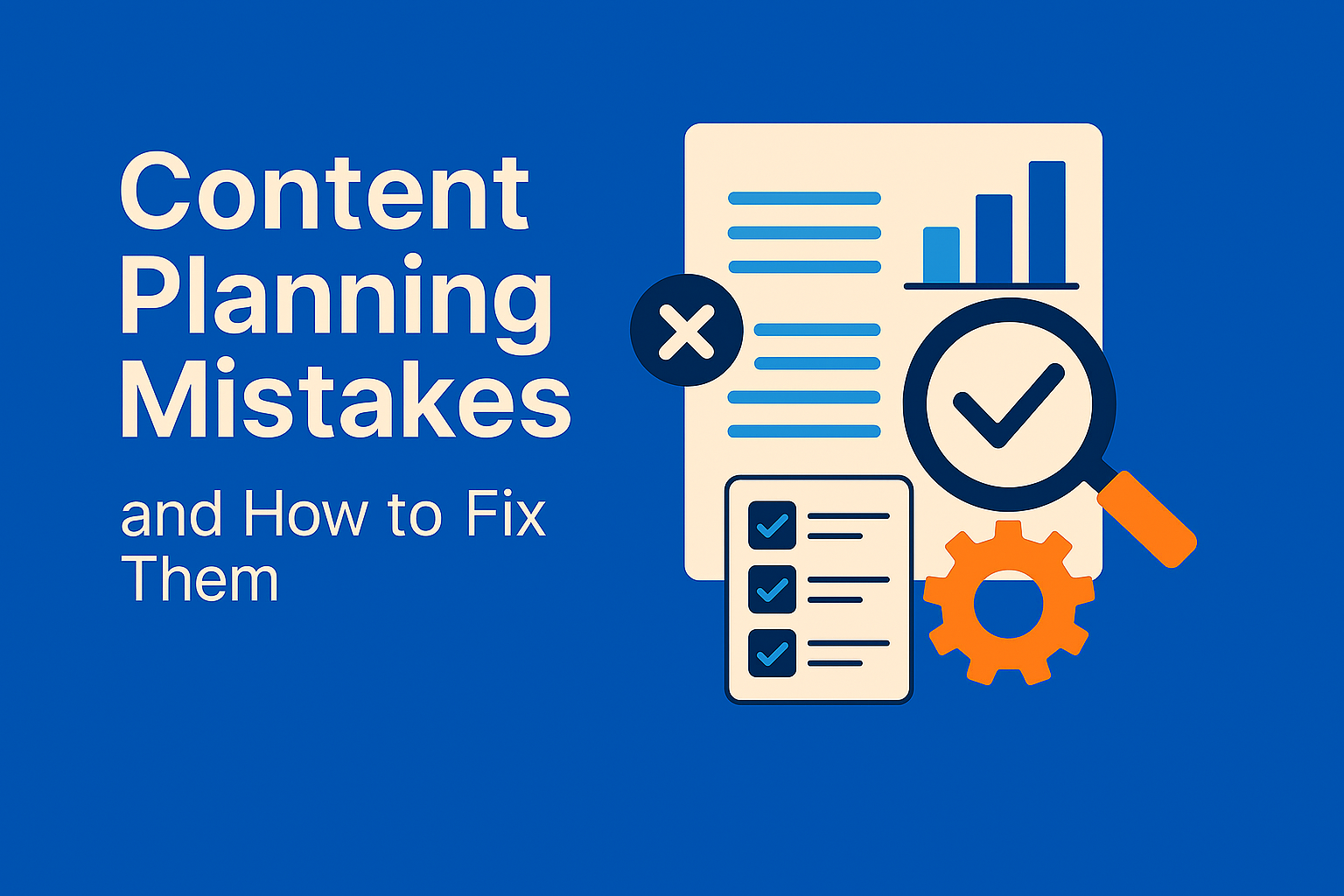
Why Content Planning Matters for Business Growth
Today's digital world moves quickly, and content is more than just words on a page. It's a powerful tool for growing a business. Whether you're writing a blog, managing a brand's social media, or coming up with a detailed content marketing plan, you need an organized content plan to be successful. Without one, companies often get stuck in a loop of releasing things at random, not getting many responses, and missing chances.
The Risks of Poor Content Planning
Imagine this: A marketing team spends weeks crafting an in-depth guide on a trending industry topic.They put it out there and share it on social media, but nothing happens. You won't see a rise in traffic, involvement, or leads. What went wrong? Most of the time, the issue isn't with the material itself, but with the lack of planning that went into making it.
Some of the most common pitfalls of poor content planning include:
✔ Inconsistent Posting – Publishing sporadically without a set schedule leads to audience disengagement.
✔ Lack of Clear Goals – Without a defined purpose, content often lacks direction and fails to drive meaningful results.
✔ Ignoring SEO – Writing content without keyword research or optimization means missing out on organic traffic.
✔ Disorganized Collaboration – When teams work in silos without a streamlined workflow, content gets stuck in endless approval loops.
How Avoiding Common Mistakes Can Boost Growth
When content is well-planned, businesses can:
✔ Improve Engagement – Delivering valuable, relevant content at the right time helps retain audiences.
✔ Boost SEO and Visibility – A structured approach ensures content is optimized and discoverable.
✔ Increase Conversions – Strategic content guides potential customers toward taking action.
✔ Save Time and Resources – With a clear roadmap, teams work more efficiently and avoid wasted efforts.
The Role of EasyContent in Content Planning
EasyContent can be a game-changer if your team is having trouble with content delays. EasyContent is different from other document sharing tools because it was made to help content creation teams simplify their processes, keep track of approvals, and keep everything in one place. Teams can work together more effectively and focus on what matters most—making high-quality material that gets results—rather than handling a bunch of spreadsheets, emails, and feedback that is spread out in different places.
Key Takeaways
- Clear content goals are essential to avoid wasted effort and low ROI.
- Audience research must guide your content direction—guessing leads to disengagement.
- Consistency in publishing increases SEO visibility and builds audience trust.
- SEO and keyword optimization should be part of the process from the start.
- Diversify formats—repurposing content boosts reach and engagement.
- Track performance regularly to optimize what works and discard what doesn't.
- Centralized collaboration prevents delays, confusion, and off-brand messaging.
Lack of Clear Goals and Strategy: The Silent Killer of Content Success
Making content without a clear goal is a mistake.
Think about this: A group of people work for weeks on a well-researched blog post, which they then post on their website and share on social media. Afterwards? Crickets. Nobody responded, shared, or bought anything. What went wrong?
Many times, the problem isn't with the material itself, but with the fact that it doesn't have a clear point. A lot of companies write content just to share it, without connecting it to a bigger plan. If you don't set clear goals, your content loses its purpose and doesn't produce any useful results.
The Impact: Wasted Effort, Low Engagement, and Minimal ROI
When content lacks a defined purpose, it leads to:
- Wasted Resources: Content creators, marketing, and writers spend time on things that don't help the business.
- Low Engagement: People don't engage with material that seems random or doesn't matter to them.
- Low ROI—It's hard to check if content is working or show its worth without a clear goal.
- Inconsistent branding: Using a lot of different types of material at once makes it hard for people to understand your brand and its message.
The Fix: Define SMART Goals for Content Creation
To transform content from a hit-or-miss effort into a strategic asset, teams should adopt the SMART goal framework:
- Clear: Say exactly what you want the content to do, like get more leads, website visitors, or social activity.
- Measurable: Make it clear what success looks like, like a 20% rise in organic traffic or 50 new email users every month.
- Reachable: Set goals that are reasonable based on past success and the resources you have access to.
- Useful: Make sure the goals of your content are related to your company's main goals (for example, write thought-provoking content to build your brand's authority).
- Time-bound: Set due dates to keep track of work and stay on track.
For example, instead of saying, “We need more blog posts,” a team could set a goal like:
"Increase organic search traffic by 25% in six months by publishing two SEO-optimized blog posts per week on trending industry topics."
How EasyContent Helps Teams Stay on Track
While having well-defined objectives is important, without the appropriate tools even the finest ideas might fail. EasyContent will assist with this as well. Its one place for content planning makes it simple to distribute jobs, monitor development, and ensure that all of the material complements general objectives. With built-in review systems, role-based cooperation, and performance monitoring, teams may accelerate the overall content production process and avoid producing material with no inherent value.
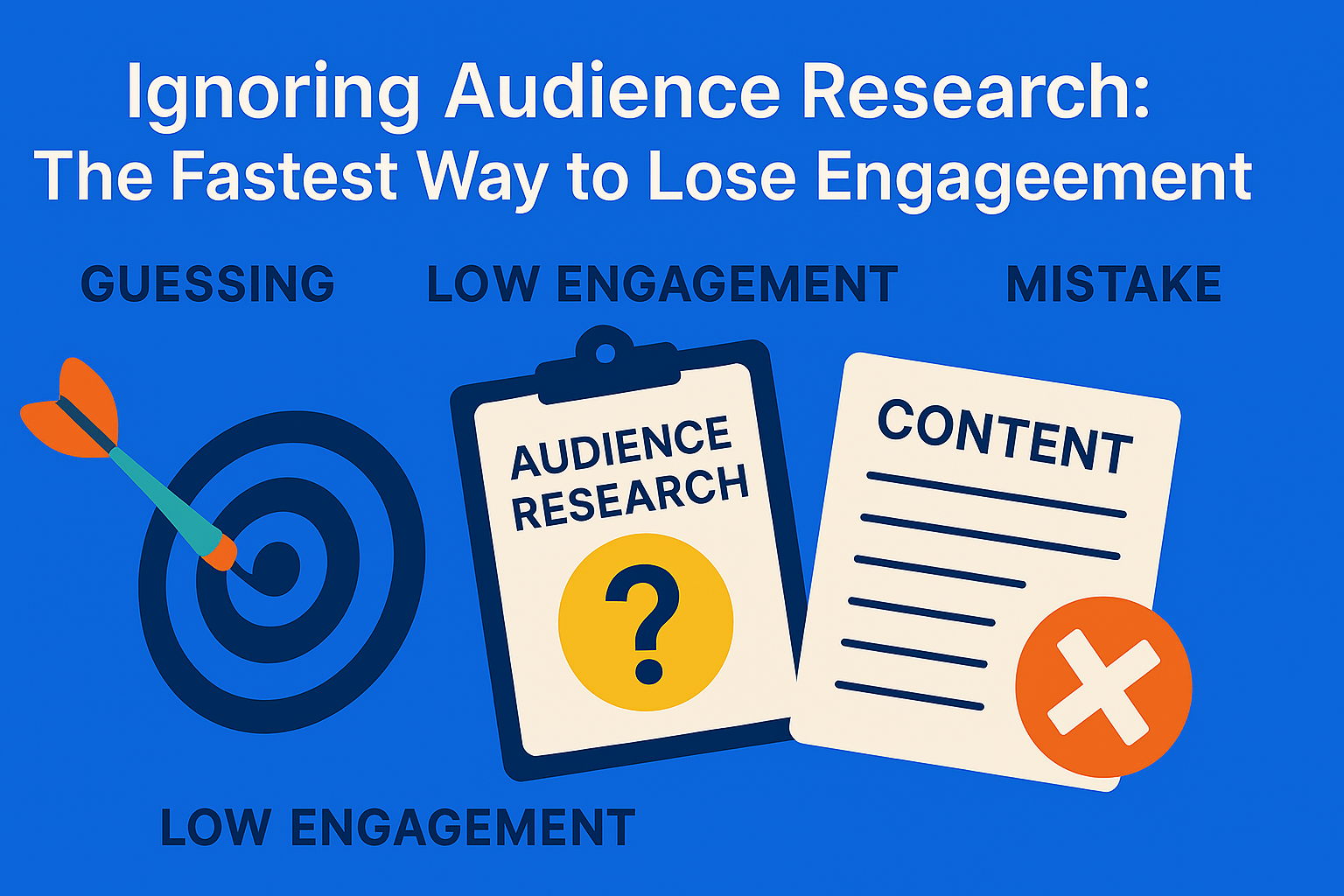
Ignoring Audience Research: The Fastest Way to Lose Engagement
The Mistake: Producing Work Without Knowing Your Readership
Imagine spending hours creating a thorough post on advanced artificial intelligence programming only to find that small company owners seeking basic automation solutions make up your readership. Businesses that neglect audience research produce content that falls short and fails to appeal to the proper individuals.
Many content teams assume they know what their audience wants, but without real data, they’re just guessing. When content doesn’t speak to the needs, pain points, and preferences of the target audience, engagement drops, and content efforts go to waste.
The Effect: Low Involvement and Unneeded Content
Ignoring audience research runs companies the risk:
❌Low engagement rates indicate that consumers won't interact with something that seems unrelated to them.
❌High bounce rates: Should visitors leave websites quickly in search of what they are looking for,
❌ Missed opportunities: Companies cannot provide real value without first recognizing areas of audience suffering.
❌ bad content marketing The materials are meaningless if the relevant people do not acquire even the best-written ones.
Creating content without audience insights is like throwing darts in the dark—you might hit the target once in a while, but most of the time, you're just wasting effort.
The Fix: Use Data to Create Content That Resonates
To ensure content connects with the right audience, businesses should invest in research methods like:
📋Polls & Surveys: Ask your audience straight forwardly about their key concerns and interests.
📊Website Analytics: Use Google Analytics or another tool to learn about issues that cause traffic and interaction.
💬Social Media Insights – Monitor conversations, comments, and shares to understand what content people value.
🗣️Customer Feedback – Talk to sales and support teams to learn what customers frequently ask about.
A firm providing marketing software, for instance, shouldn't merely produce generic blog entries on "digital marketing." Rather, audience research may show that their ideal clients battle with content approval bottlenecks, which would inspire them to offer particular, practical material on optimizing processes and enhancing teamwork.
How EasyContent Keeps Teams Audience-Focused?
Although audience metrics are great, content management around such insights might be challenging.EasyContent could help with this. Combining permissions, content planning, and teamwork into one site helps teams to modify their content strategy with the real audience need.
Easy Content guarantees that every piece of material:
🔍Aligns with audience interests;
✅Passes via the required approval channels by means of workflow automation, structured feedback loops, and built-in analytics.
📤 Published without pointless hold-downs
Teams utilizing EasyContent may monitor involvement and modify their strategy depending on actual facts instead of speculation on what might succeed.
The Impact: Missed Growth and Reduced Visibility
When brands don’t publish regularly, they lose out on key benefits like:
❌ Reduced audience retention: Should frequent changes not be seen, people forget about your business.
❌ Weaker SEO - Search engines give sites that regularly generate fresh material top priority.
❌ Unpredictable traffic spikes: Posting sporadically results in varying website and social media traffic.
❌ Reduced interest and involvement - Audiences lose interest and involvement declines without a consistent publishing rhythm.
Long-term success in content depends mostly on consistency. Brands require consistent content flow to keep consumers returning, just as TV shows release episodes at the same time every week to keep viewers interested.
The Fix: Set Up a Content Calendar for a Steady Flow
The best way to stay on track? A content calendar.
A well-planned content calendar helps teams:
- Plan subjects beforehand; there is no more last-minute content creation needed.
- Post at the appropriate times; plan your posts for when your audience is most engaged.
- Balance several content kinds – Make sure blogs, videos, social media updates, and more mix exists.
- Track deadlines — Keep editors, designers, and writers in line on schedules.
For example, a marketing team might set up a monthly schedule that includes:
📅 2 blog posts per week
📅 3 social media posts per week
📅 1 email newsletter per month
With a system like this, audiences always know when to expect new content, keeping engagement high and SEO rankings strong.
How EasyContent Preserves a Regular Publishing Calendar
Particularly for teams juggling several projects, manually managing a content schedule may be taxing. EasyContent thus becomes quite helpful in this regard.
With EasyContent, teams can:
📅Create and manage content schedules in one place – No more scattered spreadsheets or lost deadlines.
🗂️ Assign tasks and monitor development; managers, editors, and writers can work easily together.
🔄Automate reminders and approvals; never let a deadline pass once more.
🚀Guarantee of flawless content dissemination - Share material effectively on several platforms.
EasyContent keeps everything organized and on time instead of depending on speculation and last-minute preparation so teams can concentrate on developing rather than merely meeting deadlines.
Ignoring SEO and Keywords: A Costly Mistake
The error is ignoring SEO during content creation.
Although you may create the greatest article on Earth, does it really matter if none anybody discovers it?
Many companies concentrate on producing excellent material but neglect its availability. Without optimizing for SEO, they provide interesting blogs, helpful tips, and insightful commentary. That produces Their material never finds the proper audience amid thousands of rival pages.
SEO isn’t just about stuffing keywords into a text—it’s about making your content easy to find and rank higher on Google.
The Impact: Fewer Visitors and Lower Search Rankings
When content isn’t optimized, you miss out on free organic traffic. Here’s what happens when you overlook SEO:
❌ Lower search results: Google gives material that adhering to SEO best standards top priority.
❌ Missed audience possibilities: People won't read your material if they cannot locate it.
❌ Loss of credibility: While unseen material is disregarded, high-ranking material fosters confidence.
❌ Efforts wasted – A poorly written blog is like a fantastic book gathering dust on a neglected shelf.
The good news? SEO isn’t as complicated as it seems—it just takes some strategy and consistency.
The Fix: Simple SEO Tricks for Better Visibility
Small tweaks can make a big difference in how your content ranks on search engines.
- Keyword Research: Using Google Keyword Planner, Ahrefs, or Ubersuggest, discover what others are looking for.
- Use Correct Headings – Structure your content with H1, H2, and H3 tags to improve readability for search engines and readers both.
- Write concise, clear, and intriguing meta descriptions; these little snippets show up in search results.
- Boost Readability: Short paragraphs, bullet points, and simple sentences will help to enhance the reading experience.
- Internal Linking: Link to your website to boost SEO and interaction related comparable content.
- Optimise images: Clear ALT tags help to ensure photographs may be properly searched and ranked.
For instance, "Best Marketing Strategies to Increase Sales in 2025" would be a more SEO-friendly title than a generic one such "Great Marketing Strategies." One particular keyword phrase raises the possibility of ranking better.
How EasyContent Helps with SEO
SEO shouldn’t be an afterthought—it should be part of the content creation process from the start. That’s where EasyContent comes in.
With EasyContent, you can:
🔍Sort and oversee keyword research all in one location.
📋 Checklists and built-in templates will help to guarantee SEO optimization.
🤝Advance cooperation between SEO experts and authors.
📈Track performance of the materials and modify your plans.
Instead of fixing SEO mistakes later, EasyContent helps you create optimized content from the start—saving time and maximizing reach.
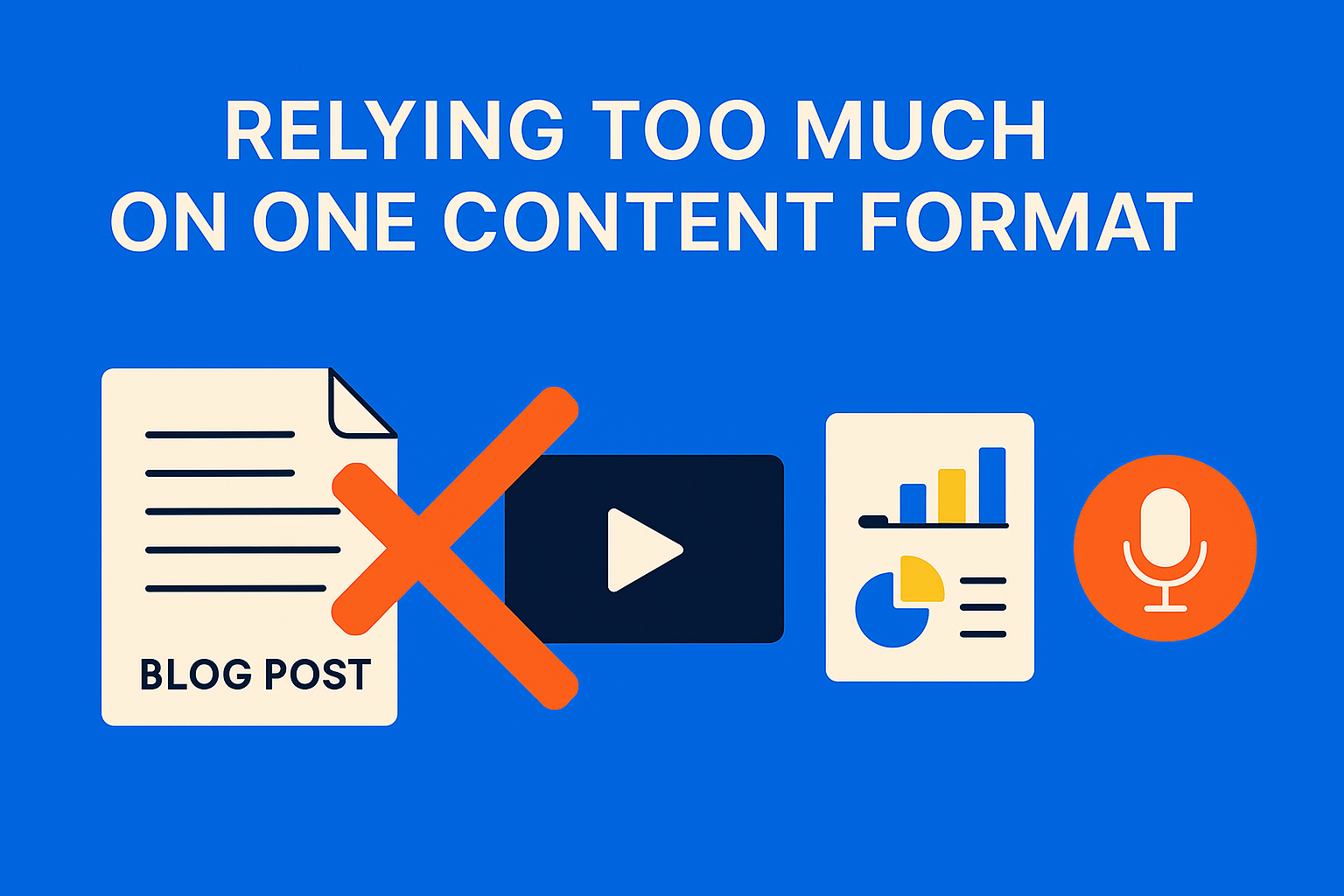
Relying Too Much on One Content Format: A Costly Mistake
The Error: Adhering to a Single Content Model
If your content plan just consists of blog entries, you might be passing on great chances for interaction. Many companies over-rely on one style—often long-form articles—without understanding that their audience views materials differently.
Blog post reading is not something everyone loves. While some people love movies, others flip through social media snippets, and still others find interactive infographics or podcasts most engaging. Ignoring diversity limits brands' reach and interaction.
Think about it: If a brand only posts written content, what happens to the audience that prefers visual or audio content? They disengage—and move to competitors who serve content in a way that fits their preferences.
The Impact: Missed Opportunities and Limited Reach
A one-size-fits-all content strategy doesn’t work. Here’s what happens when brands don’t diversify content formats:
❌ Restricted audience reach: Individuals absorb materials in different ways. Depending exclusively on one style alienates those who would rather use other media.
❌ Lower engagement: On sites like Instagram, a long blog article might not do well; instead, a fast carousel or video clip might.
❌ Wasted effort: Should a blog post fail to garner the intended momentum, it goes unseen rather than being recycled into other content forms.
❌Discovery and SEO suffer as well. Search engines respect multimodal materials. Video, infographics, and other forms increase interaction and raise ranks.
For example, a 2,000-word guide might attract some readers, but turning key points into an infographic can increase shares and engagement on Pinterest or LinkedIn.
The Fix: Repurpose Content for Maximum Impact
The key isn’t to create more content—it’s to repurpose what you already have into multiple formats.
📄 Break long-form material into bite-sized pieces; a blog article may be turned into an email newsletter, LinkedIn post, or Twitter thread.
🖼️Turn statistics from a post into images; if it calls for statistics, create an infographic or Instagram carousel.
🎥Use audio and video to translate top-notch blog entries into YouTube videos, TikHubs, or podcasts.
🎙️Repurpose webinars into short snippets: Edit highlights from your webinar into smaller clips for social media.
💬Create shareable excerpts from blogs into Instagram or Twitter quote graphics with turn-key quotations.
🤖Use AI-powered solutions to repurpose rapidly; platforms like EasyContent enable teams to simplify content repurposing so guaranteeing a consistent strategy across media.
For instance, if a business publishes an in-depth industry report, they can:
📌 Turn highlights into a LinkedIn post
📌 Create a one-minute TikTok video summarizing key findings
📌 Extract insights for an email newsletter
📌 Design an infographic for Pinterest
📌 Record a short podcast episode discussing the report
This multi-format approach guarantees that material reaches several parts of the audience, therefore increasing exposure, interaction, and conversions.
How can groups maximize EasyContent?
Content repurposing shouldn't seem like more work. Teams may:
- Organize all of your content assets for easy reusing.
- Plan, allocate, and track easily content repurposing projects.
- Guarantee of consistency across different forms by means of rules and templates.
- Work in real time; authors, designers, and social media managers keep in line on modified materials.
Rather of starting from nothing, marketers may leverage current material to save time and increase their footprint.
Failing to Track and Analyze Performance: A Costly Mistake
The Misake: Publication Without Review of Its Impact
Imagine working for hours to create and distribute materials only to never know whether it is really working. I regretfully find this happening far too often. Many content teams focus just on production as they think their work is over once products are out on sale.
The truth is, though, that you have no idea what is working or not if you are not monitoring performance.
Creating content without measuring results is like throwing darts in the dark. You might hit the target occasionally, but most of your efforts go to waste.
The Impact: Missed Opportunities and Wasted Effort
Not tracking content performance leads to several major issues:
❌ No means to gauge ROI: You have no clue whether your material is generating business growth if you neglect KPIs such traffic, engagement, or conversions.
❌ Repeating the same content errors teams do without analytics results in inadequate performance.
❌ Lack of strategy refinement: You cannot enhance your approach or maximize content for greater effect when you neglect outcome analysis.
❌ Effective content planning: You squander money on poorly performing content if you are unsure whether subjects or forms appeal most.
Imagine, for instance, a marketing team regularly releasing blog entries without considering which ones generate traffic, interaction, or conversions. Months of producing comparable material are spent just to subsequently find that their audience prefers movies or infographics. That is squandered time and effort that, with correct analytics, could have been avoided.
The Fix: Track, Measure, and Optimize Using Data
The solution is simple: Track performance and adjust your strategy accordingly.
- Use analytics tools; platforms include Google Analytics, HubSpot, and social media insights enable traffic, engagement, and conversion rate tracking.
- Track important performance markers (KPIs). Pay especially attention to organic traffic, bounce rates, duration on page, and click-through rates (CTR).
- A/B test several content types; try videos, blog entries, infographics, and case studies to see what most speaks to you.
- Repurpose excellent material: If an article has great interaction, create an email newsletter, video, or social media post from it.
- Use feedback loops. To know audience tastes, gather ideas from comments, reviews, and social sharing.
- Change depending on data: If some content categories underperform, change headlines, subjects, or formats to raise next performance.
How EasyContent Helps Teams Stay on Track
Tracking and analyzing content performance doesn’t have to be complicated. Platforms like EasyContent make the process seamless by:
📊Keeping all content performance data in one location so teams may quickly monitor what is working.
🎯Giving content teams defined objectives and KPIs will help to guarantee that every piece of work has a use.
♻️Content repurposing helps teams maximize highly performing materials for improved distribution.
🤝Encouraging teamwork so that, using actual data, authors, designers, and marketers can match their approaches.
EasyContent enables teams to make data-driven decisions instead of speculating about which content performs, therefore saving time and increasing impact.
Poor Collaboration Between Teams: A Costly Mistake
Teams functioning in silos with scattered feedback make mistakes.
You know how crazy content cooperation can be if you have ever found yourself in a position when a writer produces material while a designer works on images independently and the marketing team is left out of the loop until the very last minute.
Many teams work in silos, relying on endless email chains, Slack messages, and random Google Docs comments. Instead of a smooth workflow, content creation becomes a game of miscommunication—feedback is scattered, deadlines are missed, and messaging gets lost in the shuffle.
The Impact: Inefficiencies, Delays, and Misaligned Messaging
When collaboration breaks down, content teams face major roadblocks:
❌ Missed deadlines: Approvals take more time than required depending on comments coming from several angles.
❌ Inconsistent branding and messaging: Separately working writers and designers can produce content that doesn't fit brand identity.
Team members devote extra time searching for files, clarifying comments, and performing tasks—duplicate effort.
❌ Frustration and burnout: Bad cooperation slows things down, therefore stressing and draining the whole process.
Imagine a situation in which a writer finishes a blog piece only to find a designer wants entirely different images than first intended. Not knowing the changes, the marketing team plans the post late. The chance to publish at the perfect moment disappears by the time everything is in line.
Fix: EasyContent's centralized content collaboration
Bringing everything into one location is the easiest approach to eradicate ineffective teamwork. Teams should have a structured content center where marketers, designers, and writers may easily collaborate instead of juggling several technologies and chaotic processes.
🔄 Use a centralized platform - Teams should arrange content production, comments, and approvals in one location using solutions like EasyContent instead of emails and dispersed papers.
🧭 Clearly identify your roles and duties; from the beginning, writers, designers, editors, and marketers should know who is in charge of what.
💬 Use EasyContent's built-in commenting system to provide straightforward, actionable feedback instead of waiting on back-and-forth email chains.
🗂️ Standardize content creation processes Clearly defined steps in a well-organized process (drafting, editing, design, approval, publication) guarantees that none is excluded from the loop.
⏱️ Automate approvals and assignments — EasyContent ensures everyone understands when it's their turn to act without manual follow-ups by automating processes.
How EasyContent Fixes Collaboration Issues
EasyContent is designed to streamline content creation and team collaboration by:
📌 Centralizing content planning, approvals, and assignments – No more scattered feedback or lost files.
🧩 Providing a shared workspace where teams can track progress in real-time.
🎯 Keeping content and design teams aligned, ensuring that visuals and messaging are in sync before publication.
⏰ Automating task notifications and follow-ups, so no step is forgotten.
By integrating everything into one intuitive platform, EasyContent eliminates confusion and helps teams work smarter, not harder.
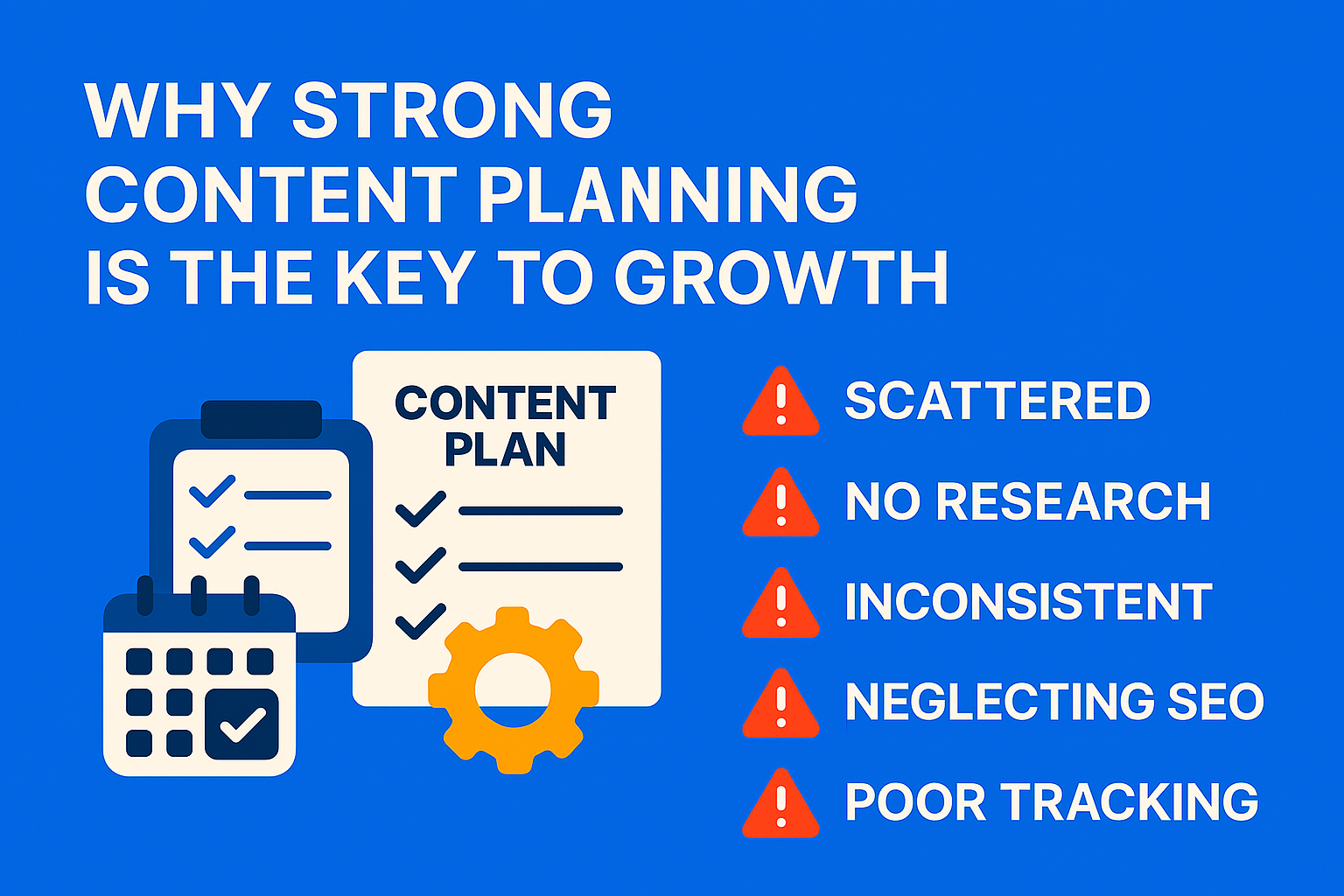
Why Strong Content Planning is the Key to Growth
Effective content planning isn’t just a nice-to-have—it’s a game-changer for business growth.
Throughout this guide, we’ve covered the biggest content planning mistakes that can slow down your success:
🚨Content attempts are scattered and ineffective without a well-defined framework, hence lacking clear aims.
🚨Ignoring audience research results produces produced content without of attraction, hence squandering effort.
🚨Inconsistent publishing: Unusual content timing causes missing audience involvement.
🚨Great content is invisible without search presence; so, depending on one style decreases audience reach. Ignoring SEO optimization results.
🚨Neglect of performance: Improving material becomes into guessing devoid of data insights.
🚨Delays in approvals arise from ineffective teams produced by inadequate coordination.
Each of these roadblocks can be avoided with the right approach and tools.
The Winning Formula: Organization, Consistency, and Groupwork
Teams must have a disciplined content strategy including these if they want to really optimize content impact:
✔ Clear goals: Every piece should enhance a measurable goal.
✔ Regular publishing schedules: a content calendar helps to ensure constant production.
✔ SEO-driven planning: improved content generates continuous natural traffic.
✔ Diverse content formats: By means of recycling material for many channels increases reach.
✔ Performance monitoring: Shape of approach is shaped by content success.
✔ Excellent teamwork: a centralized approach helps to reduce uncertainty and delays.
The best part? You don’t have to manage it all manually.
How EasyContent Makes Content Planning Effortless
If juggling multiple documents, scattered approvals, and endless revisions sounds familiar—it’s time to upgrade your content workflow.
EasyContent simplifies content planning by:
✅Consolidate content processes by keeping drafts, approvals, and comments all in one location.
✅ Automating operations will help to lower the manual follow-up required with controlled permission systems.
✅ Improving cooperation: marketers, editors, and authors all interact effortlessly.
✅ Maintaining organization - There is no more searching through files or tracking of content status.
Teams utilizing EasyContent may concentrate on producing excellent material that promotes actual corporate growth instead of battling unorganized procedures.
Ultimately, plan smarter and grow faster.
Great content results from deliberate design and execution; it cannot arise by chance.
Using the correct tools and avoiding common errors can help you turn content planning from a tedious chore into a method for growth. Thus, why not test EasyContent if you are ready to take charge of your content strategy?
🚀 Start optimizing your content planning today—and watch your business grow!




